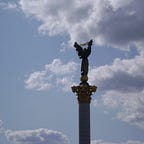The Dissidents’ Diagnosis — How the Soviets quashed sedition with psychiatry
‘The mental asylum was falling asleep. In the quiet corridors the white pearl lamps went out, and in their place, following the routine, weak blue night lights lit up, and more and more rarely could the cautious little footsteps of the medical attendants be heard on the rubber mats of the corridor outside the doors.’Bulgakov, The Master and Margarita
On the 25th of August, 1968, eight students staged a small, peaceful demonstration in Moscow’s Red Square. They were protesting about Brezhnev’s decision to send troops into Czechoslovakia three days earlier. The demonstration involved the eight young people sitting down, raising Czech flags and unfurling a banner demanding that ‘Soviet interference’ in the country be stopped. Within seconds, crowds had gathered, ripping the flags and banner from the protesters’ hands and hurling insults at them. Within minutes, ‘a number of people in plain clothes, with no insignia to distinguish them from the rest’ had arrested and beaten the protesters, driving them away in a ‘light blue Volga.’
After being tried in court, two of the protesters were found insane by the authorities. One of them, Natalya Gorbanevskaya, was detained until 1972 in a Soviet psychiatric hospital. Her book Red Square at Noon meticulously dissects the incident, its aftermath and its implications for Soviet citizens at the time. She was one of many, many victims of this form of repression under Brezhnev’s rule.
This wasn’t anything new. In 1836, Pyotr Chaadayev was declared clinically insane for his critizism of Tsar Nicholas I’s regime in a series of incendiary letters. He is generally seen as the first case of political repression using psychiatry in Russia. Bulgakov satirised this use of mental institutions in The Master and Margarita. In the novel, Ivan Nikolayevich Ponyrev is held against his will in a psychiatric hospital after attempting to report some of the incredible incidents which have befallen him. ‘They had detained a healthy man in a clinic,’ we are told, ‘and they were convinced that this was the right thing to do!’
What was life like in these institutions? In his essay ‘Concerning Special Psychiatric Hospitals (Fool’s Houses)’, P. G. Grigorenko tells us that the conditions in one such clinic, the Leningrad Psychiatric Hospital, are ‘less severe than those obtaining in prison.’ He outlines the fact that the food is better, radio and television are provided and ‘there is a very good library.’ He is also keen to highlight, however, the horrors of the system. ‘A psychiatric hospital,’ he tells us, ‘is terrifying for the sane because they are thrown among people who are psychologically disturbed. Yet the total absence of civil rights and the hopelessness of their position are no less terrifying . . . The patient lacks even the meagre rights enjoyed by other prisoners . . . the doctors can do anything they like with him and no one will interfere or defend him.’
This ominous phrase ‘anything they like’ is given further, horrific detail in Oliver Bullough’s The Last Man in Russia. Some of the patients were ‘treated with haloperidol, a powerful anti-psychotic drug that also has strong sedative properties. It was one of the few such drugs produced in the Soviet Union, explaining its popularity with Soviet doctors.’ Another favourite ‘treatment’ was to give the patients ‘regular injections of sulphazin. That was a suspension of sulphur in peach oil, which had no medical use beyond causing pain and inducing fever.’
The most prominent of the ‘special category’ clinics were the aforementioned Leningrad Psychiatric Hospital and Moscow’s Serbsky Institute for Social and Forensic Psychiatry. The latter, which as we shall see, is still used today, is ironically named after Vladimir Serbsky who apparently fought for a division to be created between the courts and the medical institutions. The fact that doctors’ diagnoses could (and still can) be influenced by political will is one of the most unsettling aspects of this story. Most political inmates of the clinics were diagnosed with ‘asymptomatic schizhophrenia’ (sometimes called ‘sluggish schizhophrenia’), a nebulous judgement which essentially allowed Soviet doctors to rubber stamp the admission of anyone they were told to into the clinics.
This kind of repression didn’t end after Brezhnev’s rule and, despite a surprising admission by the authorities that it had occurred, it didn’t end after the dissolution of the Soviet Union. You don’t have to look far to find cases in which the enemies of Putin’s regime have been institutionalised in exactly the same way. On March 6th, 2009, Viktor Grozovsky, a campaigner against Putin’s government, was forcibly hospitalised. Thankfully, he was released two weeks after his arrest after a public outcry. More recently, Nadia Savchenko, a Ukrainian officer, was captured by members of the Donbass People’s Militia and illegally transported to Russia. She was sent to the Serbsky Institute ‘for a forensic psychological evaluation.’ Savchenko is still incarcerated as I write this.
Although they are over forty years old, I see no better way to end this article than with the words of Harrison Salisbury in his introduction to Gorbanevskaya’s Red Square at Noon. Although they were intended as a description of Brezhnev’s regime, they seem just as appropriate to describe today’s Russia:
‘They ruthlessly wage war upon every manifestation of liberalism, attack, slander and suppress writers who enjoyed a brief whirl during the Khrushchevian thaw and ceaselessly propagandise not merely for the return of ‘law and order’ . . . but for a totally repressive society, backed by the terror and physical force of proletarian storm troops, imposing neo-fascism with fists and clubs.’
